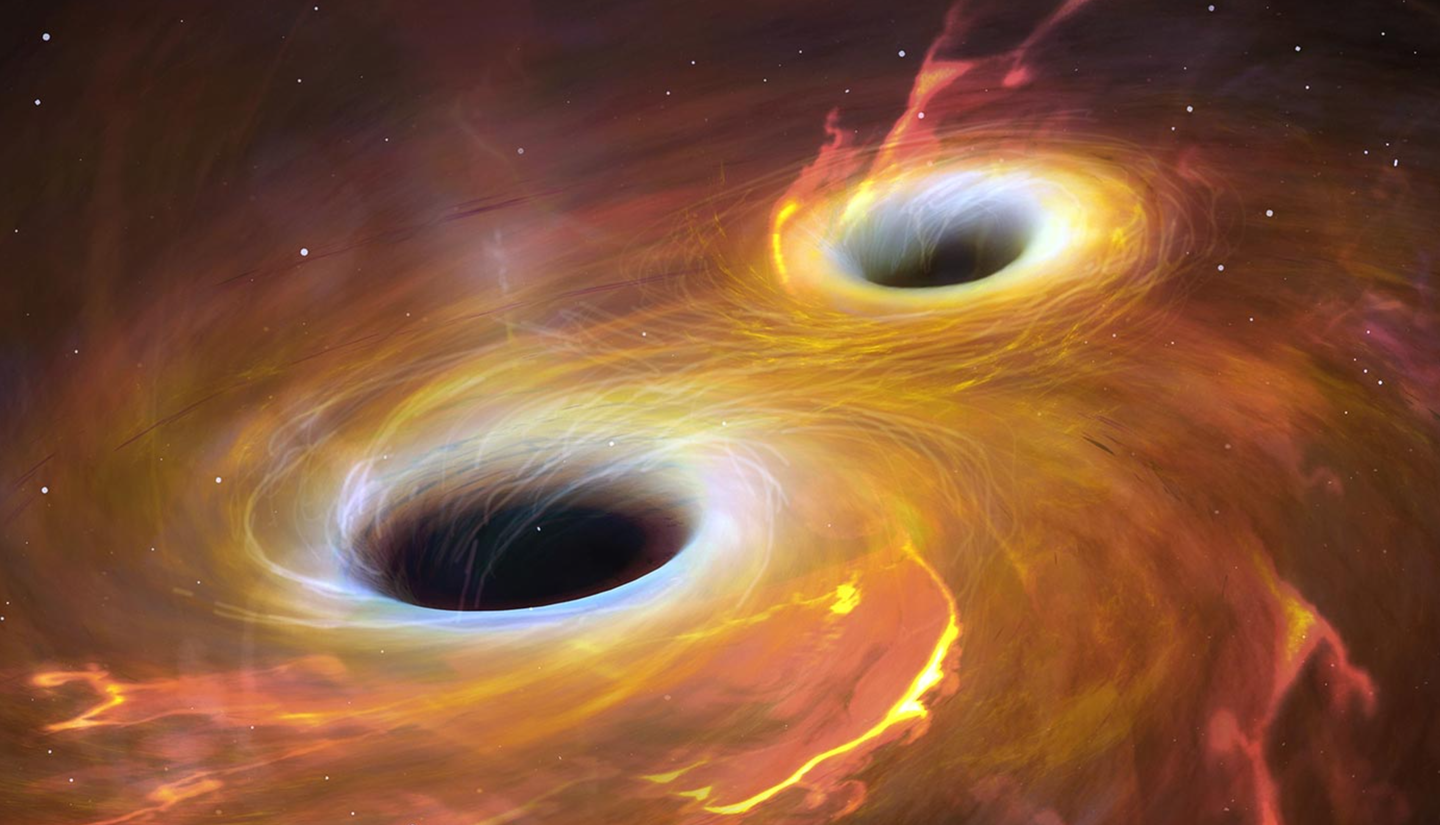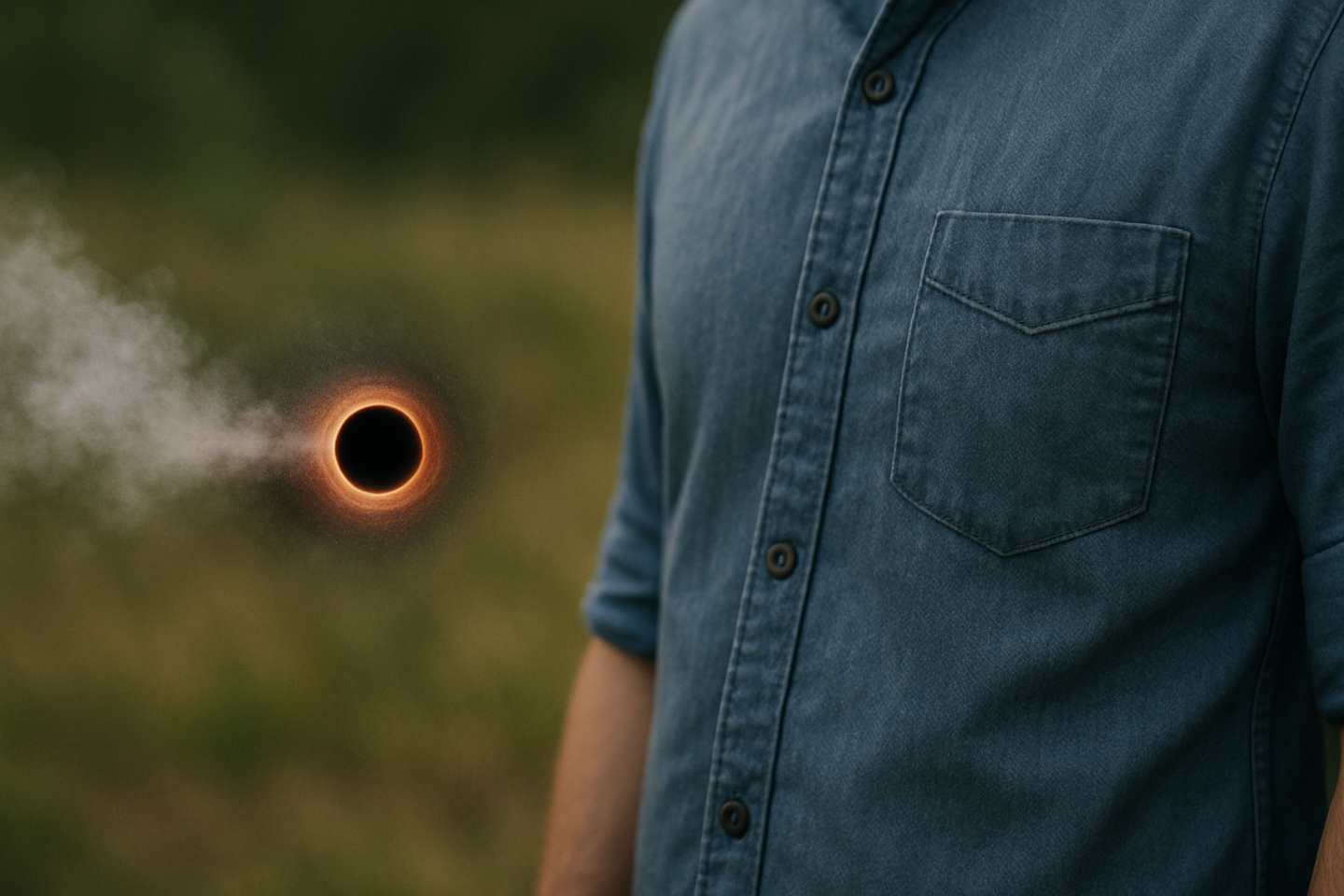Astronomers capture first-ever image of two black holes orbiting each other
Astronomers have captured the first radio image of two supermassive black holes orbiting each other in quasar OJ 287.

Astronomers have captured the first radio image of two supermassive black holes in orbit, confirming a 40-year-old prediction. (CREDIT: AI-generated image, CC BY-SA 4.0)
Astronomers had long suspected that certain quasars—those brilliant, otherworldly light sources fueled by supermassive black holes—could harbor two black holes rather than one. That theory, long considered speculative, finally has been proven.
In a historic observation, scientists have recorded the first-ever radio image in which two supermassive black holes can be seen clearly orbiting each other within a distant quasar named OJ 287.
The finding, achieved using the orbiting RadioAstron satellite and radio telescopes on Earth, delivers a startling confirmation of a 40-year-old forecast and brings a unprecedented new window on how black holes are created, travel across space, and eventually collide.
The Double Heart Quasar
OJ 287 is approximately 5 billion light-years away from us, in the constellation Cancer. It shines with great luminosity, as do other quasars, because a black hole at the center of the quasar eats gas and dust, spewing out massive amounts of energy as the material spirals toward the inside. This particular quasar has fascinated humans for decades, though, because of its strange, clocklike bursts of light.
Those occasional flashes, every 12 years or so, revealed that OJ 287 was not powered by one black hole but two—a massive one, with a mass of more than 18 billion Suns, and a smaller companion that orbits around it. Whenever the smaller one approaches, it plunges down through the disk of gas that surrounds its partner and causes an abrupt flash of light that can even be detected by amateur astronomers.
“The quasar OJ 287 is so bright that it can be detected with a modest telescope,” said Mauri Valtonen of the University of Turku in Finland, who led the research. “What makes it special is that we’ve known for decades it probably hosts two black holes, circling each other every 12 years and producing a recognizable light pattern.”
A Century of Light and a Clue Hidden
The tale of the quasar goes back to the 19th century, when it was inadvertently photographed in early surveys of the skies. No one then had even heard of black holes, and no one could ever have guessed what those little points of light were.
It was not until 1982 that graduate student Aimo Sillanpää, once more at the University of Turku, was able to see the repeating cycle of brightness in the data. He proposed that the periodic cycle was only explicable if two black holes were gravitationally bound together in orbit, distorting the stream of gas around them. His proposal was initially met with skepticism, but as additional data supported the cycle, slowly it gained acceptance.
Across decades, astronomers globally observed OJ 287's light curves, refining their models to predict exactly when each flare would appear. By matching the timing of those flares against predictions for orbital motion and general relativity, they built an incredible amount of detail into the system dynamics. But the holy grail—looking at both black holes directly—remained out of reach.
Bringing the Invisible into Focus
Normal optical telescopes are unable to tell the difference between two black holes one billion light-years away. Even the Hubble Space Telescope is not fine enough to see such details. To fill this gap, astronomers turned to a technique known as very long baseline interferometry, or VLBI, which combines radio telescopes on Earth to operate as one huge device.
By adding the orbiting RadioAstron satellite that travels half the distance to the Moon, scientists effectively made the telescope size impossible and equipped it with a 100,000 times improved resolution compared to conventional optical instruments.
When the combined system was directed at OJ 287, it observed three radio bright spots. Two of them were exactly where the double black holes of the quasar had been predicted to be, and the third was a knot in one of their jets—filaments of high-speed particles expelled from near the black holes' poles.
"They themselves are completely black," Valtonen described. "But the jets they produce are cosmic lighthouses. They help us to locate and identify the two objects."
The Wagging Jet of a Restless Companion
One of the most breathtaking new features, perhaps, is a corkscrew-like, twisted jet of matter erupting from the smaller black hole. Compared to the steady, unidirectional jet of its larger counterpart, this one "wriggles" as it shoots down the path.
They refer to it as a "wagging tail" effect—a byproduct of the smaller black hole's rapid journey through distorted space. The jet's location shifts as the black hole moves, creating a spiral effect like water shooting out of a spinning hose.
“This is the first time we’ve actually seen such a jet in a system like this,” Valtonen said. “It’s an entirely new phenomenon that tells us a lot about how jets respond to motion and gravity.”
The researchers hope that in coming years, when the smaller black hole changes velocity and position, so should the direction of the jet. Continuing observations should show this motion occurring, and it will provide a direct way to see the complex gravitational dance of the two giants.
Decades of Prediction Finally Proven
Astronomers debated for more than 40 years whether OJ 287 indeed contained two supermassive black holes. Prior observations, such as those made using NASA's TESS satellite, had hinted at double light sources but were too low resolution to confirm them. This new radio map settles that debate.
The two black holes were exactly where the models had said they would be," Valtonen said. "That agreement between theory and observation is extremely reassuring to us about how these systems work.".
The finding also verifies decades of hard labor by scientists from across the globe, who over a span of millions of nights of observation and research have kept OJ 287 under close watch. It is now clear that binary black holes are more than just theory but potentially observable directly, providing scientists with valuable evidence of galaxy collisions and their evolution through time.
Beyond the Image: What This Means for Science
To capture a picture of two supermassive black holes in orbit around each other isn't a camera trick—it's a scientific discovery. Binary black holes are thought to be the remnants of colliding galaxies, moving slowly towards each other over millions of years before being torn apart in a burst of gravitational waves. OJ 287 gives a glimpse into that occurring in action.
Through studying how the two black holes interact and the characteristics of their jets, astronomers are able to refine their accretion physics models and verify Einstein's general theory of relativity in its most severe regime. The precision with which flare times for OJ 287 have been recorded has already been utilized to test models of gravitational energy loss—effects so subtle they can only be detected in systems such as this.
This is an astronomical lab in which to see gravity at its strongest," Valtonen said. "It's showing us not just about black holes but about how the universe works."
Practical Implications of the Research
Success of this imaging campaign opens the door to study black hole pairs across the universe. Future telescopes, even more finely tuned, can track such systems over millions or billions of years, watching them slowly approach each other and coalesce.
By studying those observations, scientists will be able to predict and interpret the gravitational waves those mergers produce—ripples in spacetime that LIGO and Virgo are already sensing.
Above pure science, the accomplishment demonstrates that human ingenuity and technology can stretch the boundaries of sight. Linking a satellite halfway to the Moon with ground-based telescopes demonstrated that collaboration and persistence can reveal what was heretofore hidden.
For humanity, this accomplishment brings us closer to understanding how galaxies form, how black holes form, and how gravity governs everything we see in the universe.
Research findings are available online in The Astrophysical Journal.
Related Stories
- Black hole stars: Giant stars may hide black holes at their core
- A wormhole from another universe? Scientists revisit the puzzling black hole GW190521
- Scientists finally confirm Hawking’s black hole law strengthening Einstein’s theory of gravity
Like these kind of feel good stories? Get The Brighter Side of News' newsletter.
Joshua Shavit
Science & Technology Writer and Editor
Joshua Shavit is a Los Angeles-based science and technology writer with a passion for exploring the breakthroughs shaping the future. As a co-founder of The Brighter Side of News, he focuses on positive and transformative advancements in AI, technology, physics, engineering, robotics and space science. Joshua is currently working towards a Bachelor of Science in Business and Industrial Engineering at the University of California, Berkeley. He combines his academic background with a talent for storytelling, making complex scientific discoveries engaging and accessible. His work highlights the innovators behind the ideas, bringing readers closer to the people driving progress.



